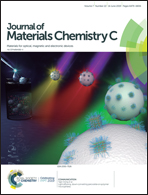A theoretical study on a series of polycyclic conjugated hydrocarbons—dinaphthobenzo[1,2:4,5]dicyclobutadienes with tunable charge transport properties by controlling [N]phenylenes and (anti)aromaticity†
Abstract
A series of cyclobutadienoid (CBD)-containing polycyclic conjugated hydrocarbons (PCHs), i.e., dinaphthobenzo[1,2:4,5]dicyclobutadienes (DNBDC1–DNBDC5), have been engineered and constructed theoretically with laddering [N]phenylene cores. In order to be aware of the relationship between aromatic degree and charge transport, we focus on the role of electronic structure, aromatic degree and some essential factors towards charge transport properties, including molecular packing, electronic coupling, charge hopping rate and charge mobility. In terms of the theoretical findings involving DFT and TDDFT methods, the most suitable [N] number in the core has been confirmed to be [N] = 2 or 3 due to the considerable electronic coupling, charge hopping rate and hole mobility of DNBDC2 and DNBDC3. Essentially, we first constructed a multi-dimensional relationship founded on the targeted [N] number, Eg and aromatic degree for predicting DNBDCs with better charge transport properties. On the basis of our findings, it seems that a scientific theoretical guide is established to study and design novel CBD-PCHs as potential organic field-effect transistor (OFET) materials.
![Graphical abstract: A theoretical study on a series of polycyclic conjugated hydrocarbons—dinaphthobenzo[1,2:4,5]dicyclobutadienes with tunable charge transport properties by controlling [N]phenylenes and (anti)aromaticity](/en/Image/Get?imageInfo.ImageType=GA&imageInfo.ImageIdentifier.ManuscriptID=C9TC01660K&imageInfo.ImageIdentifier.Year=2019)


 Please wait while we load your content...
Please wait while we load your content...